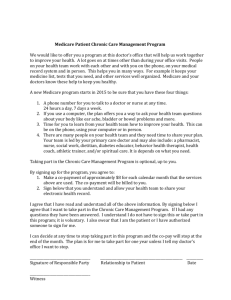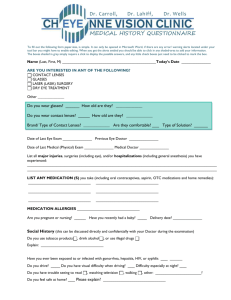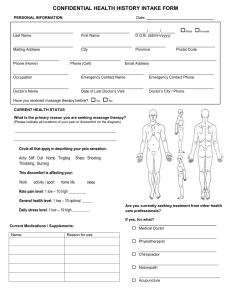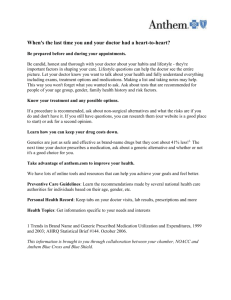AgrAbility Living with Chronic Pain
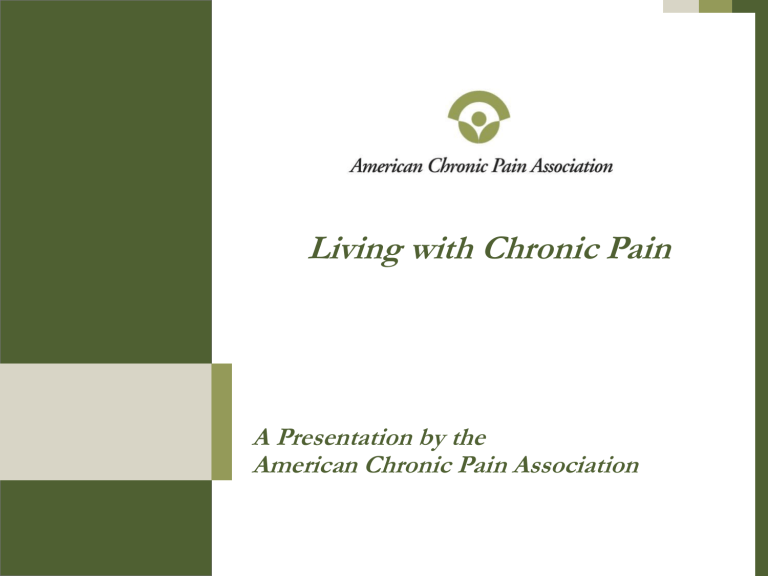
Living with Chronic Pain
A Presentation by the
American Chronic Pain Association
What is Chronic Pain?
Chronic pain is pain that:
continues a month or more beyond the usual recovery period for an injury or illness or
goes on for months or years due to a chronic condition.
The pain may not be constant but disrupts daily life.
It also can interfere with sleep, keeping you awake a night.
Pain Can Be Confusing
• You may wonder:
•Is this really pain?
•My injury has healed. Why do
I still hurt?
•How did I get it?
•Am I just imagining it?
•How can I explain it to my doctor?
People with pain need validation.
Why it is Important to Involve the Caregiver in
Manage Your Pain
When pain is not properly managed, it can end up controlling the way you and those around you live.
Many people with pain:
• Feel hopeless and depressed
• Experience sleep problems
• Have difficulty performing daily activities such as walking, going to work or even wearing clothing
It is important to talk with your doctor about all these feelings.
Talking to Your Doctor About Pain
Prepare for your visit
Before you go to the doctor, write down exactly what you think is wrong. Also include the following:
list only the new symptoms
include over the counter medicines taken
methods of relief tried, i.e. heat, message, exercise
changes in your daily level of functioning
changes in mood, appetite and sleep
questions you have
if possible take someone with you
Talking to Your Doctor About Pain
Prepare for your visit
Print out Nerve Man to show where your pain is and how it feels.
www.ittakesnerve.org
• Tools
• Where does it hurt
Talking to Your Doctor About Pain
Prepare for your visit
Use the Quality of Life Scale to explain the impact pain has on your daily life.
Talking to Your Doctor About Pain
Medications
Medications can be an important
tool to help you manage nerve pain.
They may help reduce the pain and allow you to get to sleep.
All medications have benefits and risks.
Talk with your healthcare provider about medications that may be right for you.
Talking to Your Doctor About Pain
Become part of the treatment team.
Take an active role in the recovery process.
Work with your doctor to find ways to best manage your pain.
Your goal: Reduce sense of suffering and improve quality of life.
You can live a full life in spite of pain
The Truth About Pain
Even when you and your doctor have done everything medically possible for your condition,
there may be a level of pain that you will need to live with.
The Truth About Pain
You can
live
with chronic pain
.
Learning to Live With It
Ten Steps from Patient to Person
STEP 1: Accept the Pain
Learn all you can about your physical condition. Understand that there may be no current cure and accept that you will need to deal with the fact of pain in your life.
Learning to Live With It
Ten Steps from Patient to Person
STEP 2: Get Involved
Take an active role in your own recovery.
Follow your doctor's advice and ask what you can do to move from a passive role into one of partnership in your own health care.
Learning to Live With It
Ten Steps from Patient to Person
STEP 3: Learn to Set
Priorities
Look beyond your pain to the things that are important in your life. List the things that you would like to do. Setting priorities can help you find a starting point to lead you back into a more active life.
Learning to Live With It
Ten Steps from Patient to Person
STEP 4: Set Realistic
Goals
We all walk before we run.
Set goals that are within your power to accomplish or break a larger goal down into manageable steps. And take time to enjoy your successes.
Learning to Live With It
Ten Steps from Patient to Person
STEP 5: Know Your Basic
Rights
We all have basic rights. Among these are the right to be treated with respect, to say no without guilt, to do less than humanly possible, to make mistakes, and to not need to justify your decisions, with words or pain.
Learning to Live With It
Your Basic Rights
• The right to act in a way that promotes your dignity and self respect.
• The right to be treated with respect.
• The right to make mistakes.
• The right to do less than you are humanly capable of doing.
• The right to change your mind.
• The right to ask for what you want.
• The right to take time to slow down and think before you respond.
• The right to feel that you don't have to explain everything you do and think.
• The right to say "no" and not feel guilty.
• The right to ask for information.
• The right to feel good about yourself.
• The right to ask for help or assistance.
• The right to disagree.
• The right to ask "why?"
• The right to be listened to and taken seriously when expressing your feelings.
Learning to Live With It
Ten Steps from Patient to Person
STEP 6: Recognize Emotions
Our bodies and minds are one.
Emotions directly affect physical well being. By acknowledging and dealing with your feelings, you can reduce stress and decrease the pain you feel.
Learning to Live With It
Ten Steps from Patient to Person
STEP 7: Learn to Relax
Pain increases in times of stress. Relaxation exercises are one way of reclaiming control of your body. Deep breathing, visualization, and other relaxation techniques can help you to better manage the pain you live with.
Learning to Live With It
Ten Steps from Patient to Person
STEP 8: Exercise
Most people with chronic pain fear exercise. But unused muscles feel more pain than toned flexible ones. With your doctor, identify a modest exercise program that you can do safely. As you build strength, your pain can decrease.
You'll feel better about yourself, too.
Learning to Live With It
Ten Steps from Patient to Person
STEP 9: See the Total Picture
As you learn to set priorities, reach goals, assert your basic rights, deal with your feelings, relax, and regain control of your body, you will see that pain does not need to be the center of your life. You can choose to focus on your abilities, not your disabilities. You will grow stronger in your belief that you can live a normal life in spite of chronic pain.
Learning to Live With It
Ten Steps from Patient to Person
STEP 10: Reach Out
It is estimated that one person in three suffers with some form of chronic pain. Once you have begun to find ways to manage your chronic pain problem, reach out and share what you know. Living with chronic pain is an ongoing learning experience. We all support and learn from each other.
Learning to Live With It
Ten Steps from Patient to Person
Track Your Progress
When you understand what triggers your pain, you can begin to work on ways to reduce and deal with it.
ACPA Manuals
You Are Not Alone:
Join a Support Group
Support groups can:
Help you put your pain in perspective and connect with others dealing with similar challenges.
Allow people with pain and their families to share their experiences and offer mutual support.
Provide a place to learn coping skills to help you live well in spite of your pain.
